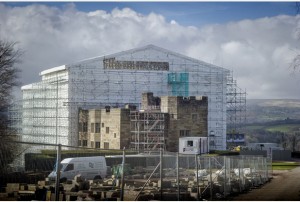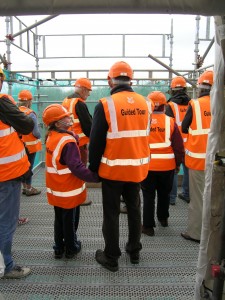I’ve visited Castle Drogo on the northern edge of Dartmoor numerous times – a wonderful ‘modern’ castle built between 1911 and 1931. Owned by the National Trust, it is billed as the ‘last castle to have been built in England’.
The Grade 1 listed, 20th century castle took considerable time to complete – I feel that these days there would be serious trouble over a 20 year build programme (during which the client moved in – surely a recipe for disaster) – but the First World War and the subsequent economic downturn took its toll on the timescale. Lutyens had to be patient to get his glossy brochure photos. And from Day 1… get this…it leaked; move over Grimshaw’s Thermae Bath Spa – you ain’t got nothing on this one.
So the ambitious project is born. Close it to the public. Make the Castle watertight for the first time in history. Open it again. Voila! Only setback is that the project, which is estimated to be a £11 million pound project, is supported by the Heritage Lottery Fund to the tune of £2.5 million pounds, with the stipulation that the Castle remains open to the public throughout. You can almost feel the pain of the CDM coordinator (as they would have been known back then – yes, before you comment, I am up to date with the new regs…). The rebuild programme starts in 2012, due to finish in 2017. Slightly late for the pre-contract meeting I roll up at Easter 2015 to see this:

Scaffolding not only close up but visible from miles and miles across the remote Dartmoor National Park. A very difficult LVIA, I would suggest.
Wandering down through the gardens, which incidentally Lutyens also designed, with teenage nephew kicking a wood ant nest on the way and generally dragging behind as, yet again, we made him visit yet another NT property, we arrived at the construction site, past a storage area with the scariest jigsaw puzzle of labelled stonework taken off the building that I’ve ever seen.
During the works the furniture has been taken out of the building, replaced with ‘art installations’ (nephew ‘loved’ this one as you would expect…). Expecting the house to virtually empty and a bit dismal we set off inside. It was, to be quite honest, more interesting than normal. Floorboards were up, detours in place, dark corners past electrical switchboards and systems controlling the water pumped up from the River Teign way below us and who knows what else (I’m no M& E engineer); we passed interesting looking signs advising on the wearing of safety equipment we didn’t have and stopped to wonder at the art we didn’t really understand – apart from the huge glass drip – symbolically pretty obvious.
Suddenly the nephew springs to life. He approaches the guide. I expect the worst – he’s shown no interest yet…but he speaks: ‘So who’s fault was it that it leaked? The architect or the builder?’ I stand gobsmacked – he’s questioning Lutyens? I corrected myself. This was what exactly what the Heritage Lottery Fund had wanted to achieve.
The answer was a gem. ‘Neither’. We all pricked up our ears. According to the guide the original roof design was domed and factored in the prolific Dartmoor weather (point to Lutyens). But… the Client (who ultimately pays the wages) wanted to be able to promenade on the roof, as he had experienced elsewhere (no doubt on equally leaky but far more historic Scottish castles). Presumably after some heated discussions, the Client got his way and the roof was created as flat, with a vast amount of granite pavers on top of the asphalt (the waterproofing roof construction material of choice at that time). So inevitably, as the asphalt dried and cracked on the exposed roof, from day one the rain crept in. It affected the lime mortar, which in turn affected the windows; it got into the services; the Dartmoor weather penetrated everything in the end. In 2012 it was do something or die, with the steel structure under threat. Presumably Lutyens said ‘I told you so’ at some point but this isn’t documented for the public eye. Shame.
So leaving the inside we climbed the viewing tower to look at the roof work from above. Scary, clanking scaffolding and horribly noisy waterproof sheeting even on a calm day. Apparently all work ceases above a certain wind speed. Not employment for the faint hearted or a pleasant experience, but great to see the guts of the ongoing work. Particularly for a 9 year old. My daughter just passed the height check (once the hard hat was in place) and joined me for the first time on a construction site. She handled the modern waterproofing material (Bauder) and had the joint welding methods explained to her. She’s now got as much knowledge as me about waterproofing. She understandably still wants to be a cartoonist.

So well done Heritage Lottery Fund, and the National Trust. You successfully engaged two young people in the construction work, who normally would have been bored by beautifully crafted Edwardian furniture and lifeless furnishings. Give them the guts of the building any day. Here’s to more bad client decisions and leaks… as long as it’s not on my projects!